Promising domestic RTK demining
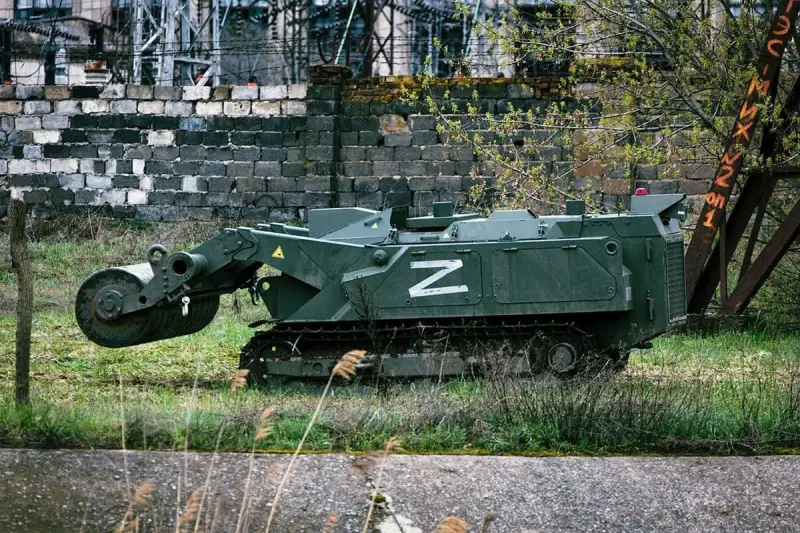
RTK "Uran-6" in Lugansk, 2022. Photo of the Russian Ministry of Defense
The Russian engineering troops are armed with robotic systems designed for clearing mines. In the last two years, such equipment has been actively used in the Special Operation zone to clear areas of dangerous objects. In addition, the industry is developing new mine clearance systems of various types and with different capabilities. Some such samples are already being tested in the combat zone and in liberated territories.
time tested
The main domestic anti-mine demining system in recent years has been the Uran-6 product. This is a remote-controlled tracked armored robot capable of carrying interchangeable working parts, incl. striker, milling or roller trawl. When moving at low speed, the RTK destroys explosive devices or provokes their detonation. This ensures clearing of a continuous strip 1,7 m wide. During operation, the operator is at a safe distance from Robot.
Presumably, the heavy RTK Prokhod-1 has been put into service. Essentially, this is a BMR-3M robotic engineering vehicle based on tank T-90. This complex is equipped with a TMT-S tank combined trawl. The latter has a set of rollers, an electromagnetic attachment and a device for sweeping anti-aircraft mines. A jamming station is also provided to suppress remote control radio channels. The TMT-S trawl ensures clearing of a strip more than 4 m wide; anti-aircraft mines are triggered within a radius of 100 m.
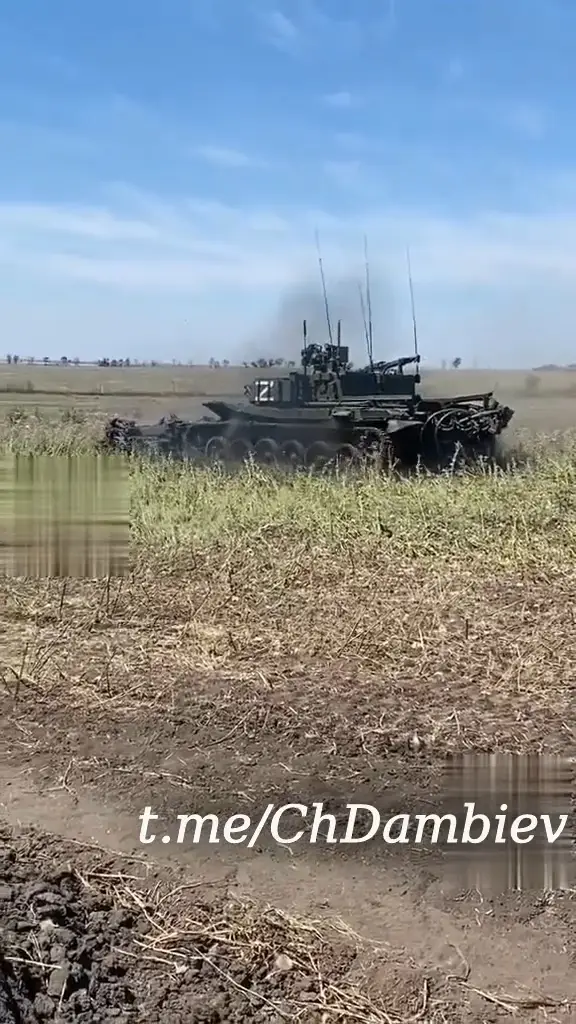
"Passage-1" in the fields of Donbass, summer 2022. Photo Telegram / Dambiev
According to known data, the Uran-6 RTKs have been used in the Special Operation almost from its very beginning - as soon as the need arose to clear the liberated territories. The heavy “Passage-1” was first noticed in the fields of Donbass in the summer of 2022. To date, complexes of existing types have made a great contribution to humanitarian demining and the restoration of normal life in the liberated territories.
Middle class
The Uran-6 RTK has proven itself well and has also shown the full potential of systems of its size. In this regard, the domestic industry has recently begun to develop similar complexes with the same capabilities, but with a different technical appearance. Some of them have already reached testing in the Special Operation zone.
Thus, in May 2023, the Kovrov Electromechanical Plant and the All-Russian Scientific Research Institute Signal (both organizations are part of the High-Precision Complexes holding of the Rostec state corporation) showed the MGR-4 or Shmel “humanitarian demining machine” to the RTK. In the middle of the year, the complex passed factory tests, and in the fall it was reported that it would soon be sent to the Donbass for testing in real conditions.
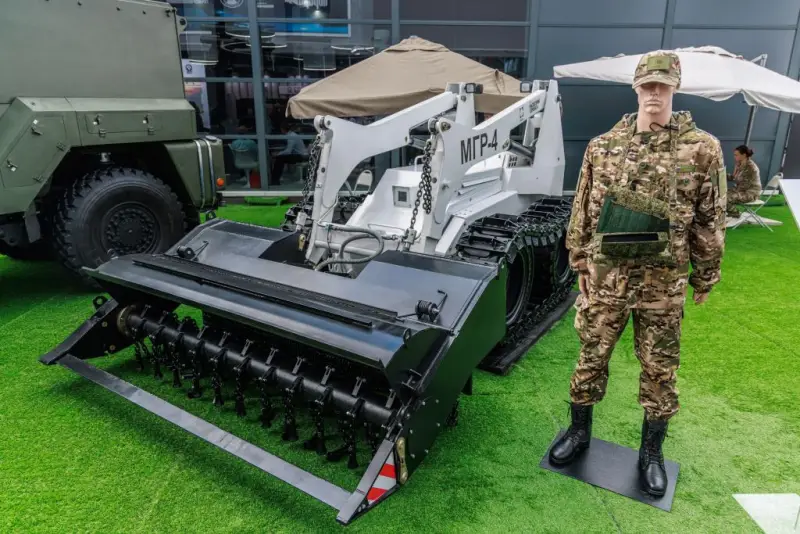
Complex MGR-4. Photo "Rostec"
The basis for the Shmel complex was the serial mini-loader Ant-1000, produced by KEMZ. The loader retained the power plant, chassis and operating units, and also received armor. At the same time, the cabin was removed from it, and fundamentally new vision and control systems were installed. MGR-4 is equipped with a chain striker trawl of the original design. This device clears a strip of approx. 2 m and works against explosive devices at a depth of up to 250 mm. The strength of the design allows it to combat anti-personnel mines and other similar threats.
To date, the MGR-4 RTK has passed two stages of testing, factory and military. During these events, he showed his characteristics, and also helped determine ways for further development of the design. Thus, at the beginning of April 2024, KEMZ presented an updated version of the Shmel with an improved trawl and other improvements.
New heavy
Right now, in the area of Avdeevka, tests are underway on another modern anti-mine clearance system called “Stalker”. In terms of the totality of characteristics and functions, this product occupies an intermediate position between the light “Uranus” and the heavy “Passage”. This provides certain advantages over each of them.
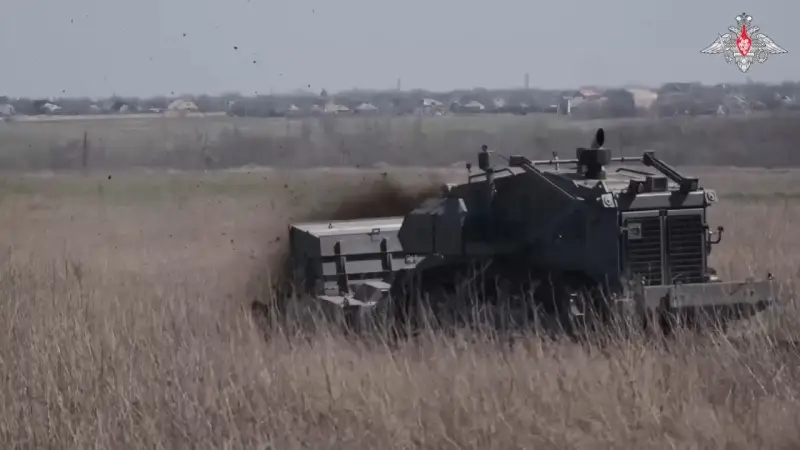
"Stalker" during testing, April 2024. Photo by the Russian Ministry of Defense
The Stalker is designed as a tracked armored vehicle, similar in layout to the Uran-6. At the same time, the new model is larger and heavier - its combat weight reaches 30 tons. On board there are all the necessary means of visibility and remote control. An operator with a control panel can be located at a distance of up to 1 km from the robot - far beyond the radius of scattering of mine fragments.
A striker trawl of traditional design has been developed for the Stalker. It provides a continuous clearing strip with a width of approx. 2 m. The trawl strikers go into the ground to a depth of 300 mm. The strength of the trawl and protection of the RTK corresponds to the tasks of neutralizing anti-personnel and anti-tank mines.
Thus, in design and operating principle, the Stalker RTK is similar to the lighter Uran-6, but its operational capabilities and tasks correspond to the full-size Prokhod / BMR-3M, which is noticeably more difficult to manufacture and operate. All the main characteristics of such a machine are confirmed during testing.
Small size product
Also in the liberated territory of the DPR, a small-sized engineering RTK "Scorpion" is used. It is intended for conducting engineering reconnaissance and detecting dangerous objects, and can also neutralize them in various ways. At the same time, the complex is characterized by its small size and certain simplicity.
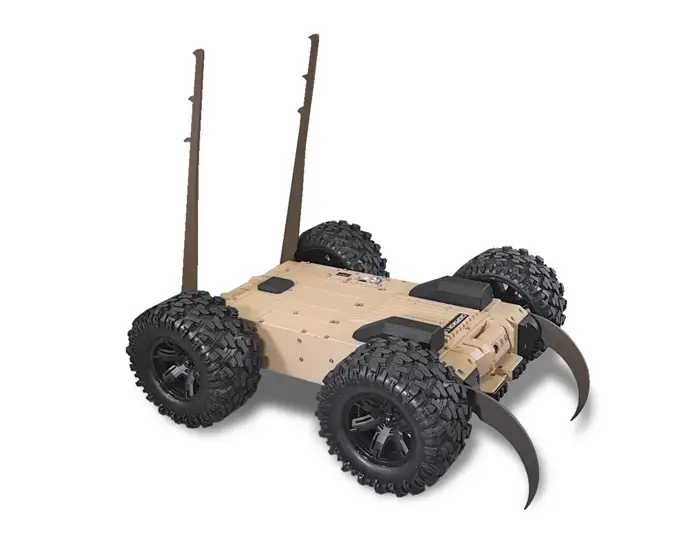
Robot "Scorpion" with attachments. Photo "SET-1"
The Scorpion RTK is actually a compact four-wheeled platform with cameras and remote control. Product weight – less than 30 kg. On a flat surface, the robot accelerates to 8-10 km/h. The device can be equipped with various devices or tow a trolley weighing 25 kg.
Using standard cameras with various adjustments, day and night illumination, the Scorpion RTK searches for and studies explosive devices. Special rods and plows are mounted on the robot body, which allow it to interact with dangerous objects. RTK is capable of tearing out stretch marks and performing other operations.
Reduced "Gorynych"
At one of the recent exhibitions, the MobiDik company (Kurgan) presented the Chelnok electric unmanned mine clearance unit (EDUR). This product differs from other existing mine clearance robots in its operating principle. It makes passages through minefields using extended engineering charges, just like installations like the UR-77 “Meteorite” do.
The "Shuttle" electronic control unit is built on the basis of the "Phoenix" all-terrain vehicle produced by the "MobiDik" company. The vehicle lost its cabin and other standard components, and instead received an original platform with a compartment for transporting extended charges, as well as an inclined launcher for a towing missile. A standard set of viewing and remote control tools is provided.
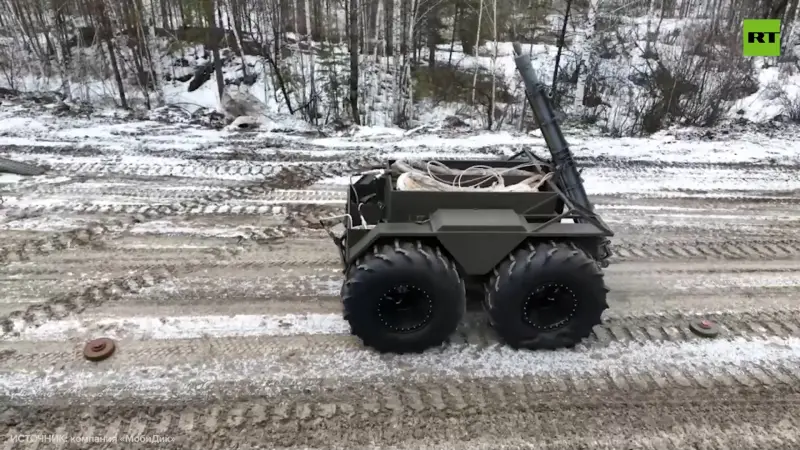
Installation "Shuttle". Photo "MobiDick" / RT
The RTK has its own weight of 1,35 tons and can carry 2 tons of cargo. On the highway it reaches speeds of up to 50 km/h and can swim no faster than 5 km/h. The chassis with low-pressure wheels provides high maneuverability on terrain and off-road, and also protects against explosions by anti-tank mines. The extended charge used, launched using a solid propellant rocket, allows you to make a passage up to 100 m long and 6 m wide.
Now “Shuttle” is undergoing factory and field tests, during which it shows the main technical and performance characteristics. In particular, the machine’s capabilities for laying an engineering charge have already been tested. It is expected that the promising EBUR will soon enter the combat zone for testing in real conditions. In addition, the development company announced a modernized version of the Chelnok. It will be shown at the future Army 2024 forum.
In a suitable role
Robotic systems have a number of obvious advantages. Their advantages can be fully used in various fields, incl. in the field of clearing territories from dangerous objects and demining. The Russian army has long appreciated this concept and adopted the corresponding types of equipment.
The high potential and necessity of the RTC for mine clearance have been repeatedly confirmed by practice. This technique was used to clear terrain in the North Caucasus, Syria, and from 2022 in the liberated territories of new regions. Positive experience in using existing technology stimulates the emergence of new samples, and right now several different RTKs are at different stages of testing. It is obvious that some of them will be able to reach adoption.
Information